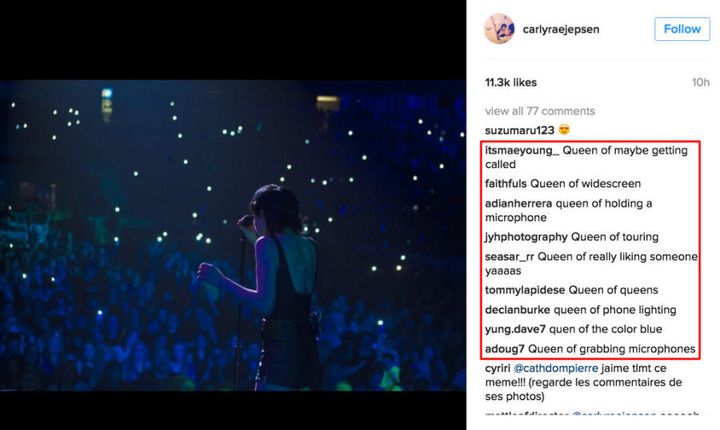
"Wait," actor, singer and DJ Ansel Elgort innocently wrote on Twitter last week, "does 'Stan' come from the Eminem song?"
Since posting, the tweet has had more than 300 responses, many with eye-rolling reaction GIFs or taunts like "where have you been living?".
But buried in those responses are the few brave people asking the simple question, "what do you mean by 'stan'?"
The term has become synonymous with hardcore fans of a celebrity, very commonly associated with female musicians whose fanbases have been given or given themselves names. Mariah Carey was one of the first, dubbing her fans "Lambs", Lady Gaga has her "Little Monsters", there's Beyoncé's "Beyhive" and "Rihanna's Navy", Justin Biebers "Beliebers" –– even the star of "The Leftovers", Amy Brenneman, has the "Brennemaniacs".
Despite most commonly being associated with musicians and often most visibly women in pop, the limits of standom are your imagination. There are Food Network stans, sports stans, Pennywise the clown from "IT" stans, YouTubers have stans, K-Pop stans –– there are even tons of stans for the young cast of Netflix's "Stranger Things".
These aren't just people who enjoy or the music or content put out by these celebrities; they're dedicated, diehard fans. They're obsessed, and they know it.
They're on "stan Twitter", a very different side of the social network to, say, politics and breaking news Twitter. It's a whole different world and a whole different language.
So how did stans get their name?
Well, Ansel Elgort wasn't wrong. It all stems back to Eminem's 2000 single of the same name.
The song is kinda dark to have inspired a whole culture. But if you haven't listened to a "So Fresh" album recently, you can be forgiven for forgetting the finer details. Stan is an Eminem superfan; he sends obsessive letters to the rapper, before eventually tying up his pregnant girlfriend in the trunk of a car and driving into a river, killing them both.
Like we said, it gets dark.
In a 2013 Rolling Stone interview, Eminem found out the name from his song had become popular parlance, much to his enjoyment.
You know "Stan" has long since entered the lexicon? People say, "I'm an Eminem Stan" or "I Stan for Katy Perry."
Wow, that's crazy. Oh, that's funny.
It's a little scary because Stan is insane.
Right....And Stan's dead! He actually died on that record. But I always had his little brother in the back of my mind. He just needed time to grow up. And come and kill me.
- Rolling Stone: Eminem Reborn: The Second Coming of Marshall Mathers.
There's a gut instinct to write off stans; to class them as "screaming teens" –– which, based on the number of times "I'm screaming" is tweeted, isn't entirely false. But that attitude ignores the more sinister inner workings of how stans engage with celebrities.
Stans are volcanic.
In 2016, Fifth Harmony's Normani Kordei quit Twitter briefly due to ongoing harassment and abuse... from Fifth Harmony stans.
In a video talking about her bandmates Kordei listed positive attributes about each, stumbling before describing Camila Cabello as, "...she is... let's see. Camilla, very quirky. Yeah, very quirky. Cute".
The innocuous comment earned Korei so much scorn from within Fifth Harmony fandom that those "Harmonizers" who were Cabello stans began to troll the other member of the group, driving her off Twitter for a period of time -- just as Eminem's Stan drove off a bridge into a river.
More recently, the cast of "Stranger Things" had to navigate this intense relationship with fans, after actor Finn Wolfhard failed to say hello to a crowd that was waiting for him outside his hotel. "Game of Thrones" actor Sophie Turner came to Wolfhard's defense after stans began attacking him for being "heartless".
Wolfhard himself even tweeted about it, attempting to talk some sense into his irascible fanbase.
There's a fine, fine line that stans tread between fanatic and troll –– a line which makes the adoption of Eminem's song more appropriate, because they're expressing their love through hate.
Through the popularisation of social media like Twitter and Tumblr, stans were thrown into an gladiator's arena of fanbases. Mariah's stans clashed with Ariana Grande's, and Rihanna's Navy and the Beyhive famously refusing to get along. It was the rise of "stan wars".
In the early days, prior to the rise of sites like Tumblr and Twitter, on which stanning became outward facing, fan sites and forums were dedicated to particular celebrities. Fans could exist in an isolated space, where they could revel in their favourite icons without tension from other fandoms.
The shift from forums to social media also created accessibility. With the rise of Twitter, Instagram, Snapchat, Tumblr and Facebook, fans are able to communicate directly with celebrities. This has given rise to an intimacy; the chance that your fave could be reading your tweets while you hurl ironic abuse or over-the-top praise at them encourages fans to dedicate their accounts to celebrities.
Bebe Rexha told 'EW' in an interview that she loves having the ability to communicate directly with fans. "I get yelled at! I'm like, 'I'm sorry!' They'll send me pictures with knives. I'm like, 'You guys are too much!'"
It may sound like stans are a group of overly involved individuals –– the kind that old dudes would roll their eyes at, casting aspersions on the frivolity of being too involved in pop culture, while simultaneously taking days off from work to watch football games.
Sure, old dudes, cast all the aspersions you want.
Aside from the drama and chaos of stans, there's organisation and action. The purest form of standom is wanting a celebrity to succeed, usually above all others.
When Lady Gaga was releasing her single "Perfect Illusion", Little Monsters were role-playing as soccer mums and older women in order to convince radio stations that diverse crowds were requesting the song.
BuzzFeed uncovered this trend that attempts to drum up more airtime for a single.
"My children let out the loudest scream," one account wrote, "I dropped my casserole tray in the kitchen!"
Stans are organised, they're dedicated and -- at times -- completely unhinged.
In early 2016, Carly Rae Jepsen was inundated with stans responding to every Instagram and Tweet with a formulaic "Queen of ***". On an Instagram post that Jepsen uploaded of a meal at her grandmother's house, comments ranged from "Queen of old people", "queen of food", "queen of humble beginnings" to "queen of leaving prescriptions out on the counter".

It is often a one-sided relationship, but while there's not always reciprocation from the celebrity, there's a whole web of other like-minded fans.
Being a stan is to be part of a community that's in on the joke, even if the artist may not be.
Some of Britney Spears' stans refer to their idol as "Knee" –– not just as a shortening of her name, but in honour of her 2004 knee injury. It's not cruel, so much as lovingly tongue-in-cheek.
Similarly, the phrase "skinny legend" gets thrown around, which an Urban Dictionary definition describes as a celebrity, animal or even inanimate object that is "glamorous and talented, no matter their weight".
Scan any story about theories for decoding messages and themes within an artist's work, and at the core of it are stans. When Taylor Swift wiped her entire social media presence in the lead-up to announcing her upcoming album "Reputation", her stans went into overdrive with theories.
From scanning Swift's website for hints within the code, to becoming experts in ancient mythology, her standom dug deep to try to uncover any clues they could.
Stans aren't just superfans –– they're a community of like-minded souls coming together, unified under the banner of wanting to see their chosen celebrity flourish. Friendships are made, bonding over a shared love of an artist, their work and their achievements.
Even after the glitz and glamour of standom fades, those relationships are what remains. To be a stan is to felt and seen; to have something to anchor yourself to.
And what's life without a little passion?
